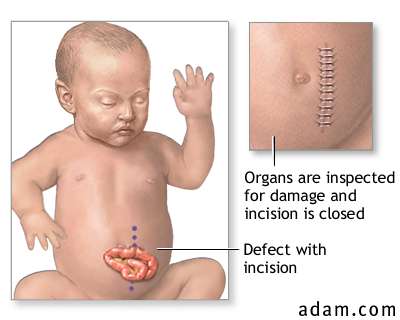|
|
|
Procedure
|

|
|

|
|

|
Surgical repair of abdominal-wall defects involves replacing the abdominal organs back inside of the abdomen; repairing the defect, if possible; or creating a sterile pouch to protect the intestines while they are gradually pushed back inside of the abdomen.
Immediately after delivery, the exposed organs are covered with warm, moist, sterile dressings. A tube is inserted into the stomach (nasogastric tube, also called NG tube) to keep it empty. This prevents choking on stomach contents or breathing (aspiration) the stomach contents into the lungs. The surgery is performed as soon as the infant is stable.
While the infant is deep asleep and pain-free (using general anesthesia), an incision is made to enlarge the hole in the abdominal wall. The bowel is examined closely for signs of damage, or additional birth defects. Damaged or defective portions are removed, and the healthy edges are stitched together. A tube is inserted into the stomach (gastrostomy tube) and out through the skin. The organs are replaced inside of the abdominal cavity and the incision is closed.
If the abdominal cavity is too small, or the protruding organs are too swollen to allow the skin to be closed, a pouch is made from a sheet of plastic to cover and protect the organs. Complete closure is done over a few weeks. Surgery might be necessary to repair the abdominal muscles at a later time.
Sometimes the infant's abdomen is smaller than normal. Placing the abdominal organs inside of the abdomen increases pressure within the abdominal cavity, and can cause breathing difficulties. Use of a breathing tube and machine (ventilator) might be required for a few days or weeks until the swelling of the abdominal organs has decreased, and the size of the abdomen has increased. The outcome depends on the amount of damage to the intestines, but most defects are successfully corrected with surgery.
|
|

|
The information provided herein should not be used for diagnosis or treatment of any medical condition. A licensed physician should be consulted for diagnosis and treatment of any and all medical conditions. Copyright 2000 adam.com, Inc. Any duplication or distribution of the information contained herein is strictly prohibited.
|
|